Downs Hospital for Children
Banstead Road, Sutton, Surrey
Medical dates:
Medical character:
Specialist
In 1882 the South Metropolitan
District Schools purchased a 19 acre site from the Sutton Lodge estate
on the east side of Banstead Road (later renamed Cotswold Road).
The original school in Brighton Road (which later became the Belmont Hospital) had become cramped and new accommodation was needed.
The new institution opened in 1884. The design was based on a pavilion block layout, with six two-storey H-shaped buildings. (Although there were two WCs on each floor, the entire site contained only two bathrooms).
Originally intended to accommodate up to 400 infants, by the 1890s the institution had become the Girls' School, the boys remaining at the original Brighton Road site. One hundred girls aged 8 years or more lived in each of the six blocks. By 1898 649 girls were resident at the School.
In 1902 the School closed and the buildings were purchased by the Metropolitan Asylums Board, who reopened them in 1903 as the Downs School for children suffering from ringworm and other skin and scalp diseases.
During the 19th century ringworm, a fungal infection, was spread mainly through barbers, schoolchildren and theatre seats. It had been noted that lesions healed better without hair, so treatment consisted of plucking out the hair strand by strand, or applying pitch plaster, then tearing out the hair. At the beginning of the 20th century. infected children were segregated and sent to special schools which offered education and the new X-ray epilation treatment. The radiation led to their hair falling out and later, for some, iatrogenic cancers of the scalp. (Anti-fungal medication is now available for ringworm treatment.)
In 1913 non-tubercular children were transferred to the Goldie Leigh Children's Cottage Homes, which also specialised in ringworm cases, and the Downs School became a TB hospital for children - the Downs Sanatorium.
In 1920 it was renamed the Downs Children's Infirmary and, in 1922, it absorbed the Cleveland Street Children's Infirmary. In 1924 its name changed again, to the Downs Hospital for Children.
By 1938 the Hospital had 360 beds.
During WW2 the Hospital was damaged by bombs and one nurse was killed.
It closed in 1948 at the beginning of the NHS.
Present status (August 2008)
The buildings were occupied by the Sutton Hospital, the Institute for Cancer Research and the Sutton branch of the Royal Marsden Hospital. The administration block was demolished in the late 1990s but the other original buildings remain, albeit largely boarded up.
The new institution opened in 1884. The design was based on a pavilion block layout, with six two-storey H-shaped buildings. (Although there were two WCs on each floor, the entire site contained only two bathrooms).
Originally intended to accommodate up to 400 infants, by the 1890s the institution had become the Girls' School, the boys remaining at the original Brighton Road site. One hundred girls aged 8 years or more lived in each of the six blocks. By 1898 649 girls were resident at the School.
In 1902 the School closed and the buildings were purchased by the Metropolitan Asylums Board, who reopened them in 1903 as the Downs School for children suffering from ringworm and other skin and scalp diseases.
During the 19th century ringworm, a fungal infection, was spread mainly through barbers, schoolchildren and theatre seats. It had been noted that lesions healed better without hair, so treatment consisted of plucking out the hair strand by strand, or applying pitch plaster, then tearing out the hair. At the beginning of the 20th century. infected children were segregated and sent to special schools which offered education and the new X-ray epilation treatment. The radiation led to their hair falling out and later, for some, iatrogenic cancers of the scalp. (Anti-fungal medication is now available for ringworm treatment.)
In 1913 non-tubercular children were transferred to the Goldie Leigh Children's Cottage Homes, which also specialised in ringworm cases, and the Downs School became a TB hospital for children - the Downs Sanatorium.
In 1920 it was renamed the Downs Children's Infirmary and, in 1922, it absorbed the Cleveland Street Children's Infirmary. In 1924 its name changed again, to the Downs Hospital for Children.
By 1938 the Hospital had 360 beds.
During WW2 the Hospital was damaged by bombs and one nurse was killed.
It closed in 1948 at the beginning of the NHS.
Present status (August 2008)
The buildings were occupied by the Sutton Hospital, the Institute for Cancer Research and the Sutton branch of the Royal Marsden Hospital. The administration block was demolished in the late 1990s but the other original buildings remain, albeit largely boarded up.
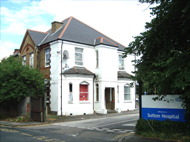
The former L-shaped probationary block at the entrance of the site, now part of Sutton Hospital.
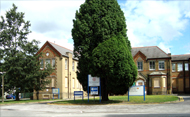
The signage of Sutton Hospital is seen in the foreground with the Downs Hospital buildings at the back.
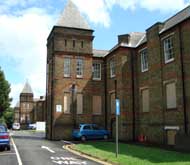
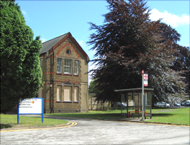
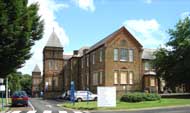

The original ward blocks of the Downs Hospital are now mostly no longer in use and have been boarded up.
Cochrane Shanks S 1967 Vale epilatio. X-ray epilation of the scalp at Goldie Leigh Hospital, Woolwich (1922-58). British Journal of Dermatology 79, 237-238.
Lydon FL, Stephanides T, Robb TM 1949 Ringworm of the scalp. British Medical Journal 1 (4603), 523-524.
http://vetmed.illinois.edu
www.bscra.com
www.workhouses.org
Return to home page